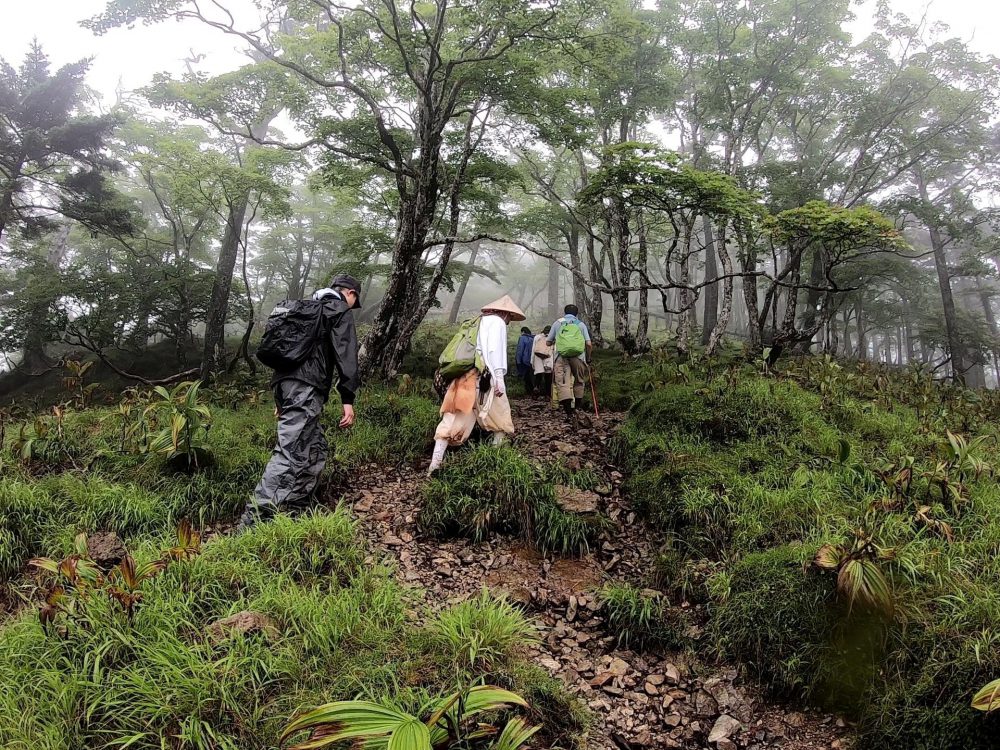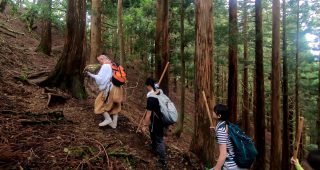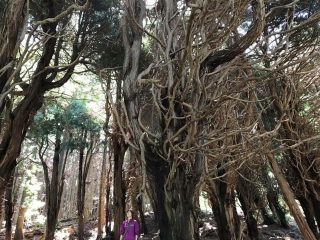Shakagatake (meaning Gautama Buddha Peak) is a mountain located in the southernmost town of Totsukawa in Nara Prefecture. Though difficult to reach (vehicle transportation is a must), the scenery of the hike is one of the most beautiful of the region, making it well worth the journey. Despite the lack of cooperation from the weather when I visited (basically was inside of a rain cloud the entire time), it was still one of the most scenic hikes I have done during my time living in Japan.
The majority of the course follows a ridgeline and is characterized by spacious forest, sweeping mountain prairies, and dramatic scenery of the surrounding region. I found that the openness of the hike was overall its strongest point, as there are very few trails in the Kansai region that are not smothered by artificial cedar or cypress forest. As someone who comes from the desert, these kinds of spaces are something that I have come to greatly miss during my outings into nature.
Roots in Nature Worship
The reason this beautiful trail exists is that Shakagatake’s peak is considered a sacred destination point on the ancient Okugakemichi Pilgrimage Route, which runs from the Yoshino River in the north, all the way down to the Kumano Hongu Taisha Shrine in the south (a distance of around 90 kilometers). This route is widely considered to be linked to the old Kumano Kodo walking routes that criss-cross the Kii Peninsula, though it is by far the least accessible and most rugged. Though other routes of the Kumano Kodo have exploded in popularity recently among tourists (both domestic and international), the Okugakemichi is still a seldomly traversed route that should appeal to those willing to forgo some comforts in favor of immersion in nature and solitude.
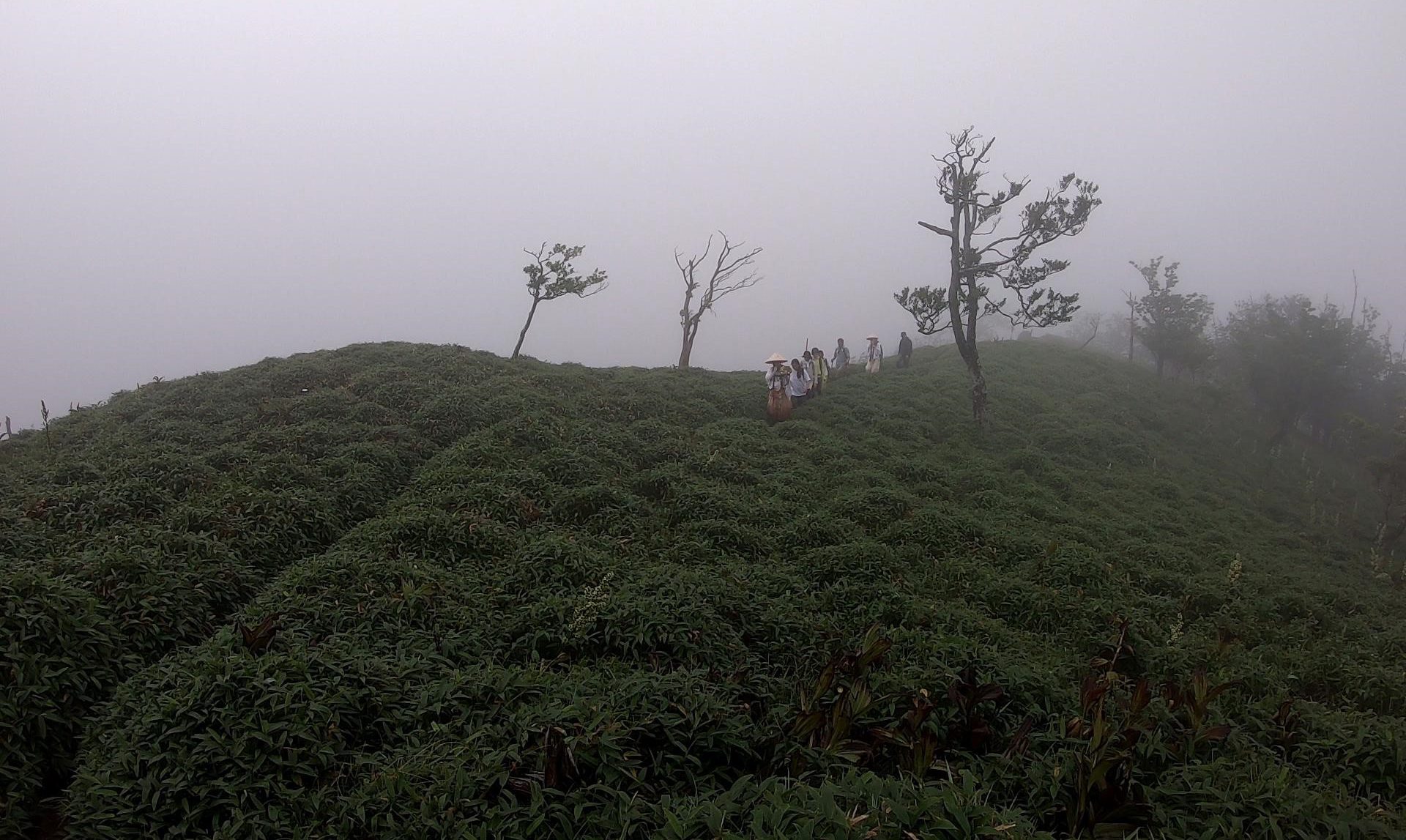
Mountain ascetics have been using these paths, much in the same way as the people pictures here, for at least 1,300 years.
The Okugakemichi a route mainly used for religious purposes by practitioners of the ancient nature-worshipping tradition known as Shugendo. Shugendo holds that mountains are holy (a different world from our own) and that doing ascetic training in them is a crucial aspect of religious practice. Though its origins are in ancient nature worship, Shugendo is a syncretic faith that includes both both Buddhist and Shinto ideas, with mountains such as Shakagate (a powerful manifestation of nature, named after a Buddhist deity) being a prime example of this concept. At the very top of the peak, there is actually a metal statue of Gautama Buddha that legend says was carried up and assembled by 1 man over 3 seperate ascents.
It is not unusual to see practitioners of the Shugendo faith (known as “yamabushi”) passing by silently on the trail and stopping at the top to conduct prayers. The guide for the ascent on which this article was written is a yamabushi (Mr. Otsuka) who was kind enough to allow us to join him during his spiritual practice of mountain shugyo (“spiritual training”). As someone who finds this ancient tradition of Shugendo to be very fascinating, I was absolutely thrilled to be invited along.
The purpose of ascending these mountains for yamabushi is not for the joy of recreation but for the pursuit of a higher state of being at one with holy nature. Through this higher state, practitioners believe they can make the world a better place by devoting themselves to helping others. Old historical records of Japan tell of yamabushi going from town to town, offering their spiritual services to locals in various ways from communicating with higher powers to exorcism. All of these services enabled by power bestowed upon them from holy nature during their time doing shugyo.
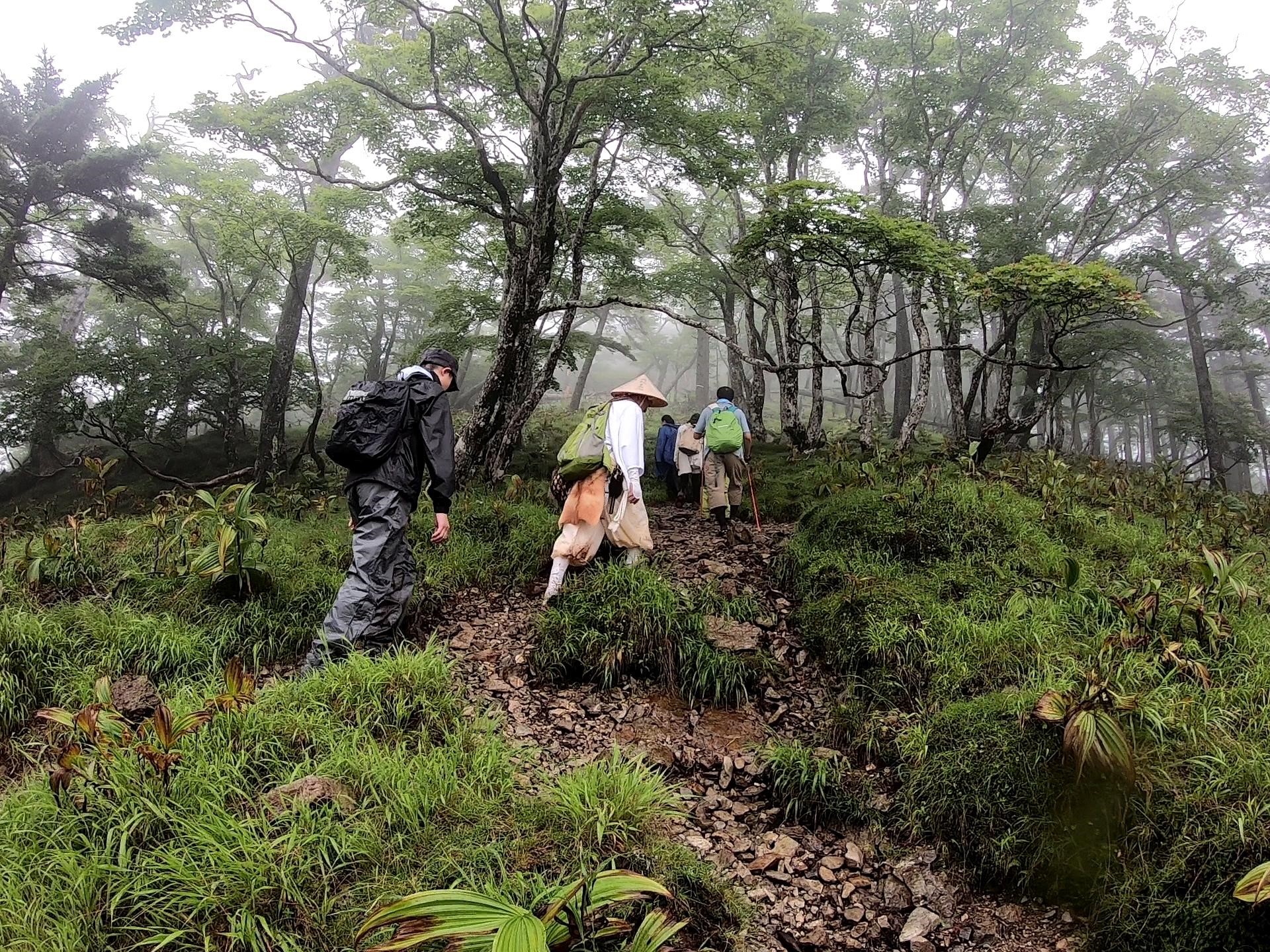
The Hike
As mentioned before, the mountain itself lies within the boundaries of Totsukawa Village, which is known as the “largest village in Japan” due to its huge area, though the population is actually quite small, numbering less than 3,500. Totsukawa makes up the southernmost section of Nara Prefecture and contains some of the most remote mountains in all of the Kansai region. Besides remote peaks, Totsukawa is famed for its mountainside townscapes, pure hot springs, and special historical sites related to Shugendo worship.
The trailhead is located next to a small parking lot way up a ways on the side of the mountain. You can feel the elevation difference as soon as you get out of the car, and in our case, the exposure to the elements. As the reality of the rainy situation dawned on us, we all got prepared to deal with a very wet hike, putting on our raincoats, and me leaving behind my more expensive stabilizer equipment for my camera, which I still had not had a chance to actually use in these mountains due to repeated occurrences of bad weather. Why hike in the rain, you may ask? Well, yamabushi do not save reserve practice for just sunny days, and will go out in any kind of weather to practice, with the rain being considered just another important mood of the sacred natural world.

Offering prayers to Mt. Shakagatake at the trailhead.
Mr. Otsuka, our guide and head priest of Daisan-ji Temple in the town of Yoshino, advised us to wear long sleeves and pants, despite the oppressive heat of the Japanese summer. This advice was due to the fact that the mountain environment of Japan is home to a type of leech that hangs out on trees and shrubs, waiting for a passerby to cling to for a snack. They are not that dangerous in that they simply suck your blood (rather than spread disease, etc.), and are also nice enough to patch up the wound they make on you with a coating of their own saliva. Pretty great, huh? Despite the hospitality of the leeches, we all dressed our best to protect ourselves from them as they are apparently pretty clever little suckers and are willing to search your body thoroughly until they can find any exposed skin. If someone did get a leech, it would almost certainly have been considered appropriate to just think of it as another form of natural shugyo.
After being treated to horror stories about all the different places people have found leeches on their body after hikes like the one we were about to do, the journey finally began with the call of the conch shell horn (known as a horagai) our leader carried, followed by a ritual prayer before the entrance of the trailhead.
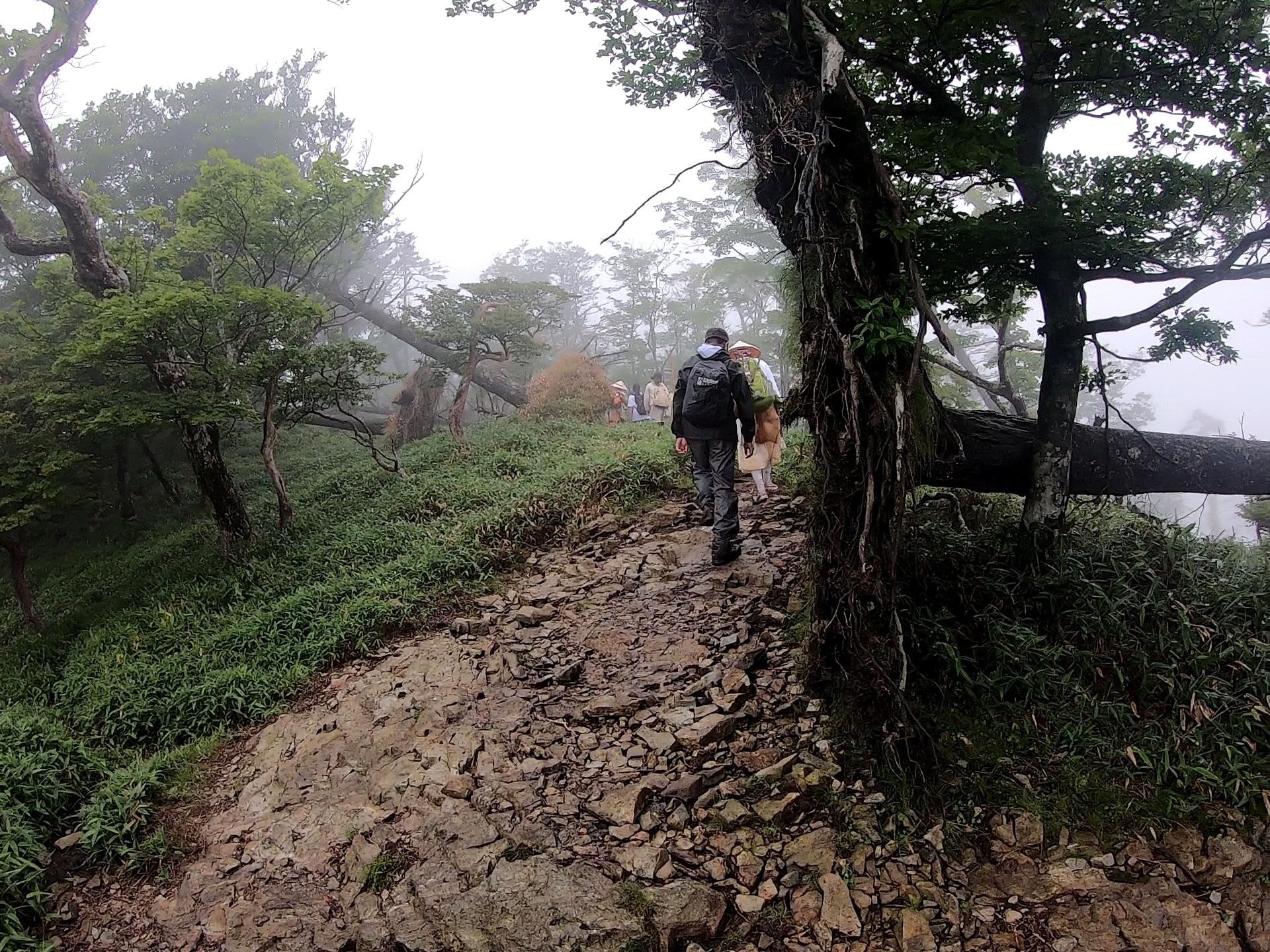 Fallen trees lined the trail all the way to the peak, suggesting that the previous year’s typhoon had quite an effect on the area.
Fallen trees lined the trail all the way to the peak, suggesting that the previous year’s typhoon had quite an effect on the area.
As luck would have it, nobody would end up having any problems with leeches on this day. Maybe because it was too wet even for them. The trail was a mud filled slog and the going was slow under the unrelenting rain. The atmosphere, on the other hand, was fantastic, with the trail following an interesting ridgeline of grassy meadows separated by patches of trees. Eventually this grass would transition into a kind of mountain shrub, equally green and vibrant in the wet weather. Despite the rain, I think everyone felt an appreciation for the beautiful surrounding environment. Under the clouds, rain, and fog, the isolation from the rest of the world felt palpable, submerged deep in the sacred realm of the mountain and far from the comforts of the artificial towns and cities we call home. To me it felt like we were walking through a time long past, with only the crinkling sounds of our modern rain-proof gear to suggest otherwise.
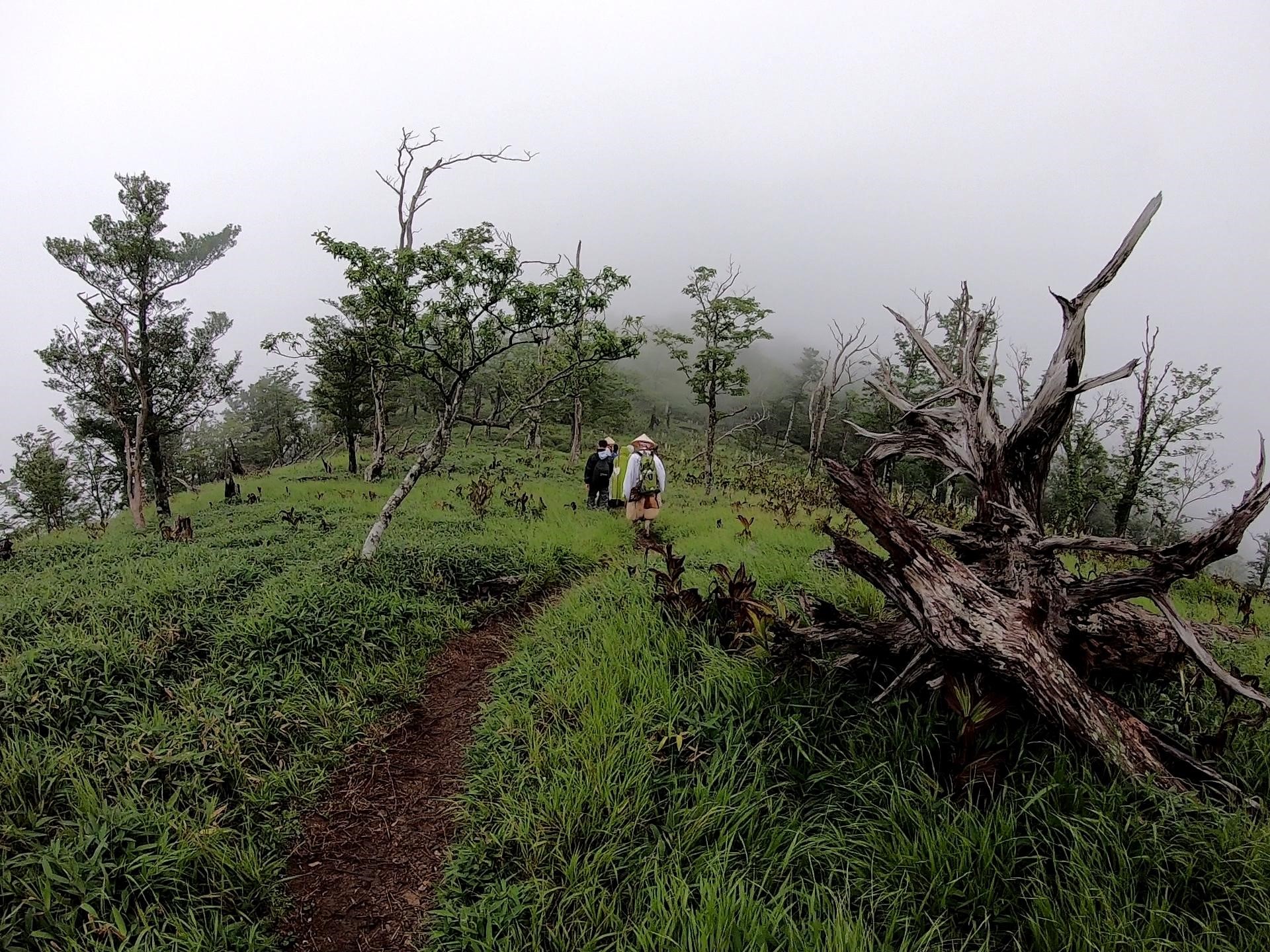
A moment of brief respite from the rain, in which the fog formed a kind of dome over the ridgeline.
We hiked in silence up and down the small peaks of the ridgeline trail, with the call of the conch shell breaking silence every now and then to signal our approach. This silent walking is part of the spiritual aspect of the journey, allowing us to focus on the shugyo of ascending the mountain. After about an hour of walking, we finally hit the final stretch to the peak, which was about 40 minutes or so of nonstop uphill made all the more hazardous by the slick trails.
The peak of Shakagatake had views much the same as everywhere else on the hike, in that there was none to see. Just swirling depths of grey cloud greeted us alongside the an impressive old metal statue of Shaka Buddha. Though I can say with some confidence that on a clear day it must be an amazing sight, with a 360 degree panoramic view of the entire region available. After getting settled, our guide conducted a prayer ritual before the solemn statue of Shaka and quickly decided to lead us back down to a small shelter for lunch. The walk down and subsequent traversal back to the main trail was much more hazardous than the hike up, with everyone falling at least once in the mud of the trail; even our experienced guide took a spill at one point. One woman actually took a tumble off the edge of the trail, flipping foot over head for about 10 meters before stopping but was lucky enough to escape serious injury. Despite all of this, we were all able to make it back to the parking lot okay after about 5 hours of walking.
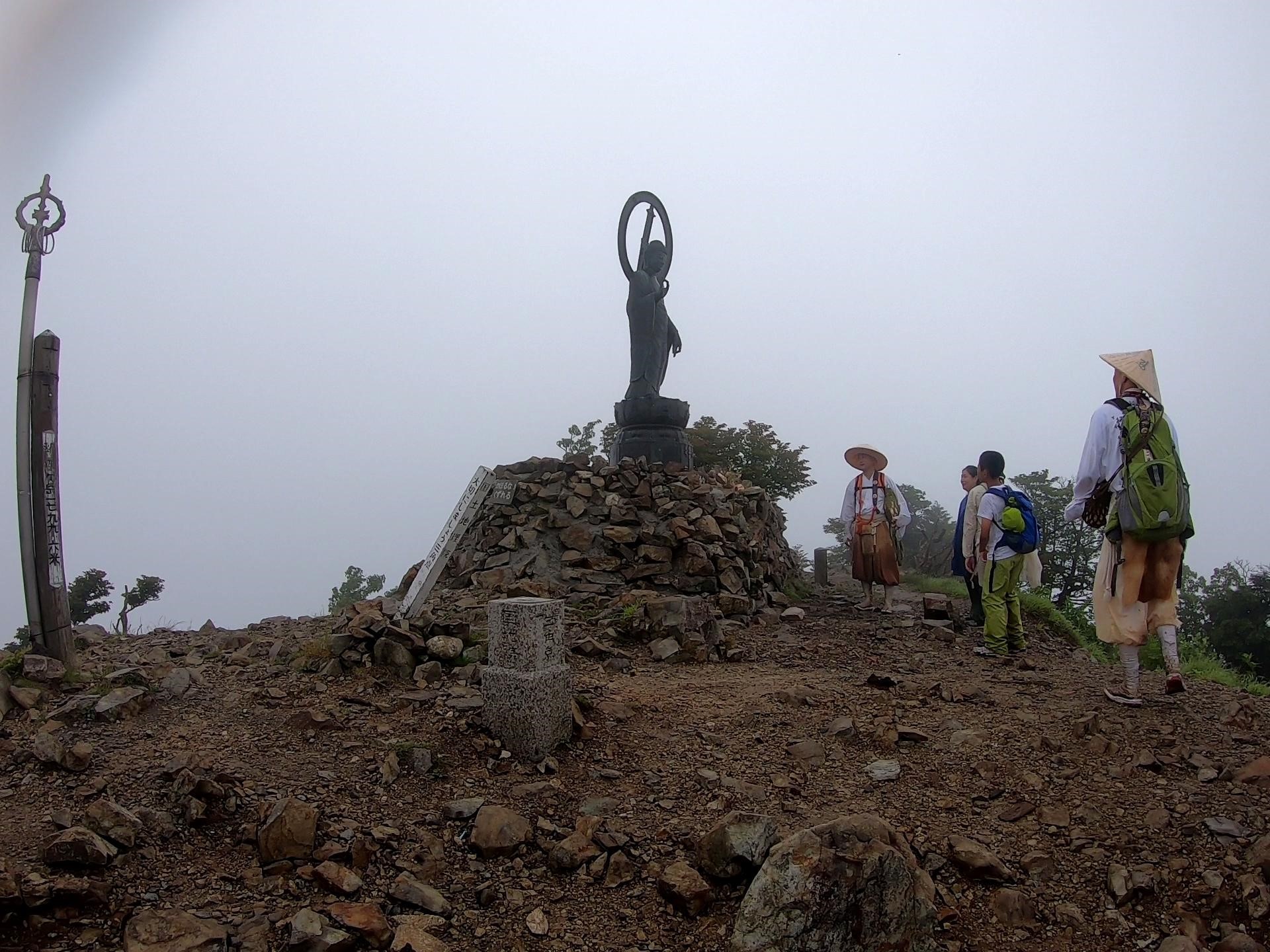
Statue of Gautama Buddha on the peak.
Before finishing the experience, we did one last ritual prayer facing towards the peak of the mountain. Though the weather was bleak, we had completed our goal and did so under the instruction of a yamabushi who led us in manner of the countless generations of worshippers that came before him. He reminded us that it did not really matter what weather it had been, as our enjoyment was not a factor, but rather what we had done was completed for a greater purpose than ourselves. Furthermore, through reconnecting with sacred nature, we in turn strengthen our own spirits.
Adversity was a gift from nature that gave us the chance to become stronger. To gain some grit, as you might put it. Truly, as beautiful as the mountainous pilgrimage trails of this region might be, it is the spiritual purpose which forged them through the mountains which ultimately sets them apart and makes them unlike any other place in the world.
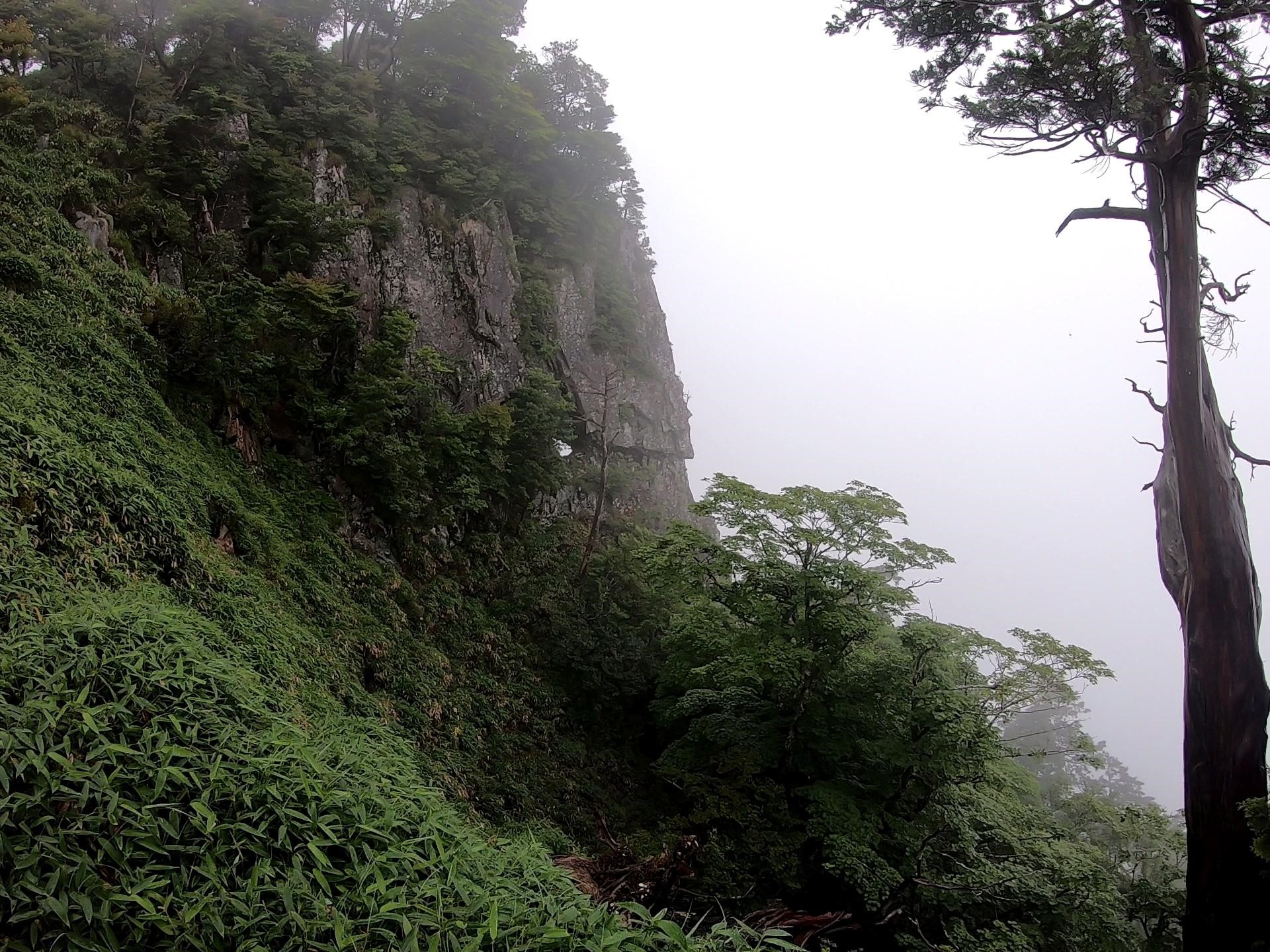
An eye in a jutting out buttress of rock near the peak.
The day finally ended with a refreshing dip in a local onsen hot spring in Totsukawa village. It has to be said that one of the best aspects of hiking in Japan is the inevitable call for a dip in a local hot spring aftwards, which is almost always located somewhere within a reasonable distance of wherever you might find yourself in this wonderful country. And after a muddy day in the pouring rain, there is no better feeling then immersing yourself in a steaming hot bath.

